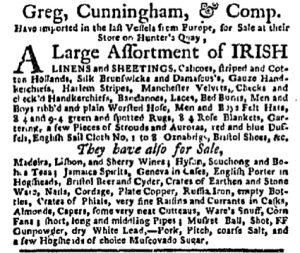GUEST CURATOR: Nicholas Commesso
What was advertised in a colonial American newspaper 250 years ago today?

Today’s advertisement features Greg, Cunningham, & Company and their vast assortment of all different types of goods recently “imported in the last Vessels from Europe.” Fairly unlike any other advertisements I have looked at this week, this shop offered more than a surplus of different textiles and clothing materials, such as “LINENS and SHEETINGS,” laces, velvets, and handkerchiefs, Greg, Cunningham, and Company also carried products that would be found in a modern hardware and sporting goods store. Materials like “Russia Iron,” gunpowder and musket balls were available as well as “Plate Copper” and “dry White Lead.” I had not seen these products advertised before; they stood out because they show that colonists needed supplies that allowed for expansion, growth, and opportunities for new development. From the hardware products to clothing to even a selection of medicines, Greg, Cunningham, and Company offered a diverse selection of goods to consumers.
The advertisement also listed “Ware’s Snuff.” Since it was listed with “middling pipes” and different alcoholic beverages, at first glance I assumed “Ware’s Snuff” was just another pleasure for adults. In fact snuff was extremely popular among men, not only as a product to enjoy, but as a social measure as well. According to Edwin Tunis, “Nearly every man carried the most expensive [snuff box] he could afford.” Some had a different box for every day. Even women took advantage of the readily available product, but only in private.[1] However, after researching further, I found that “Ware’s Snuff” was actually used as a cure for some sicknesses as well. Taking this up the nose would often lead to “a very large discharge of mucus.”[2]
**********
ADDITIONAL COMMENTARY: Carl Robert Keyes
Nick focused on the content of the advertisement he selected for today, but I am also interested in the context in which it appeared. Today’s advertisement was included in a half sheet Occasional Supplement to W. Weyman’s Gazette of Yesterday. Like nearly half of colonial American newspapers published in 1766, William Weyman distributed the New-York Gazette on Mondays – and, usually, only Mondays. Typically, each issue consisted of four pages, two printed on each side of a broadsheet that was then folded in half. In most cases, that was the extent of the news and advertising made available by any particular newspaper during any particular week.
At this time the Pennsylvania Gazette did provide a notable departure. It frequently inserted an additional half sheet in its standard four-page issue, bringing the entire issue to a total of six pages. Even with this additional content, however, the Pennsylvania Gazette did not attempt to distribute additional full issues more than once a week. In the 1770s some newspapers experimented with printing two or three issues per week, but it was not until after the Revolution that newspapers in the largest cities began daily publication.
This brings us back to Greg, Cunningham, and Company’s advertisement and the Occasional Supplement to the New-York Gazette in which it appeared. Why deviate from the usual publication schedule? Considering the amount of labor involved in producing an additional half sheet, why have an Occasional Supplement appear just one day after Monday’s regular issue, rather than later in the week? The “Subject of the Day is quite altered,” the first line of the Occasional Supplement proclaimed, due to “the Arrival of the Lord Hyde Packet” and the news it carried “with regard to the Change in the Ministry.” At the end of July, Lord Rockingham had been dismissed as prime minister. The king instructed William Pitt the Elder to form a government and granted him a title, making him the first Earl of Chatham. Pitt was popular among American colonists, both for his incisive leadership during the Seven Years War and, especially, for his opposition to the Stamp Act. Yet the Occasional Supplement noted that in Britain “there is pro and con, for and against Mr. PITT.” Weyman selected excerpts from letters that arrived on the packet ship “to give both Sides a Chance, and must leave our Readers to judge for themselves.” This news was too significant to wait an entire week to report it in the next issue of the New-York Gazette, hence Weyman’s decision to rush to press with an Occasional Supplement.
This news filled almost the entire first page of the Occasional Supplement, but the other side featured advertisements (including Greg, Cunningham, and Company’s advertisement) exclusively. Sometimes supplements and additional half sheets (like those that accompanied the Pennsylvania Gazette in 1766) were mechanisms for distributing additional advertising, the demand for advertising space exceeding the what was available in regular issues. In this case, however, we see that political reporting opened an opportunity to distribute greater numbers of advertisements. Weyman and others who worked in his shop could have cut their work in half by printing a broadside that reported the news, but instead chose to print advertising on the other side before distributing the Occasional Supplement on September 30, 1766.
**********
[1] Edwin Tunis, Colonial Craftsmen and the Beginnings of American Industry (New York: World Publishing Company, 1965), 53.
[2] Thomas John Graham, Modern Domestic Medicine (London: Published for the Author, 1827), 369.
